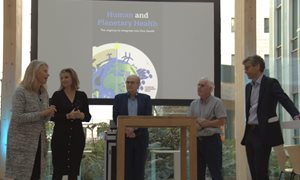
Her Majesty Queen Máxima paid a working visit to Radboudumc on Wednesday, July 1st, where she learned about the hospital's approach to sustainability and circularity in healthcare. Integration of sustainability in education, reusable medical devices, and the redistribution of medications: Radboudumc is at the forefront of making healthcare more sustainable and is working towards circular healthcare by 2050.
The royal visit focused on the circularity ladder with its three pillars: refuse, reuse, and recycle. Queen Máxima was welcomed by Bertine Lahuis, Chair of the Executive Board, and was presented with an extensive program where Radboudumc staff showcased sustainable initiatives and results.

Collaboration with partners is crucial
"We cannot make healthcare sustainable on our own," says Harriette Laurijsen, strategic advisor for sustainability at Radboudumc. "Change is needed at the system level. That's why we collaborate with partners such as suppliers, other hospitals, health insurers, and the government. Queen Máxima's visit underscores the importance of our mission. We are honored to have been able to showcase our approach. The attention to sustainability from the Royal House increases awareness around this theme, giving a powerful boost to the sustainability of the healthcare sector."
Sustainability starts with education and research
Queen Máxima began her visit with a discussion on sustainability in medical education. In the elective course "Green Medicine," future doctors learn about the relationship between climate, environment, and health, explained Tim Stobernack, researcher and lecturer in healthcare sustainability. "Based on the results of our research into the environmental impact of healthcare and the health effects of environmental pollution or climate change on human health, we provide students with the tools and knowledge to make a difference as future doctors."
From operating room to waste station
In the operating rooms, Queen Máxima saw how the Green Team OR works towards an operating room with minimal environmental impact. Surgical assistant Gertie van der Molen demonstrated the different waste streams and showed how small behavioral changes can have a big impact. For example, by using materials more consciously, such as cellulose mats, thousands of euros are saved annually and CO2 emissions are significantly reduced. Queen Máxima also heard about innovative research into the redistribution of medications. This project, led by researcher Charlotte Bekker, has been rolled out to all university medical centers and eight top clinical and general hospitals. This saves millions of euros annually in the Netherlands. The tour also included a brief stop at the Central Sterilization Department (CSA), where medical devices are sterilized for reuse. Sustainability efforts in the OR mean that more devices need to be sterilized.
The visit ended at Radboudumc's waste station, where team coordinator Wim Joosten explained to Queen Máxima how the different waste streams are processed. He explained how Radboudumc works with 50 different waste streams to recycle materials as high-quality as possible. Finally, Queen Máxima spoke with partners about the importance of collaboration for making healthcare more sustainable. Together with health insurers, waste processors, and regional hospitals, we are taking healthcare sustainability to the next level. The regional project 'The Circular Hospital,' which investigates how medical waste can be recycled using new techniques, was presented as an example.

At the table with Her Majesty were(from left to right): Kevin Overgoor (Manager of Medical Device Procurement), Twan Joosten (CWZ), Harriette Laurijsen, Jan Pessers (ARN), Bertine Lahuis, Esther Willems (VGZ)
Climate goals for 2030 already achieved
Radboudumc has long identified sustainability as one of its strategic priorities and strives to make the OR as green as possible. By signing the Green Deal Sustainable Healthcare, the hospital committed to a 55% CO2 reduction by 2030. This goal was already achieved in 2022, and the hospital continues to work towards as much climate-neutral and circular healthcare as possible by 2050.
Concrete examples of our approach
- In 2024, a direct CO2 reduction of 76% was achieved compared to the reference year 1998.
- Indirect CO2 emissions are reduced by sustainable procurement and promoting sustainable transport. For example, we use more sustainable medical devices such as reusable blood pressure cuffs, tourniquets, and isolation gowns.
- Sustainable transport: for example, the use of a double-decker truck for laundry transport. This has reduced CO2 emissions from laundry transport by 46%.
- We reduce waste: for example, 40,000 fewer plastic bed covers annually by switching to washable bed covers and eliminating disposable bed covers

Photo: Bram Kurstjens (Logistics Manager), Her Majesty, Harriette Laurijsen
More about our view on sustainability and circularity:
- Sustainable healthcare - Radboudumc
- More sustainability in healthcare | Sustainable healthcare | Government of the Netherlands
- The Green OR - Radboudumc
-
Want to know more about these subjects? Click on the buttons below for more news.
More information
Related news items

Give environment and prevention a place in new health care design Surgeon Kees van Laarhoven Radboudumc predicts the 6th economic cycle in his book Human and Planetary Health
7 October 2023Surgeon Kees van Laarhoven presented his book Human and Planetary Health - The urgency to integrate into One Health. He advocates for the importance of a healthy planet to improve human health.
go to page




